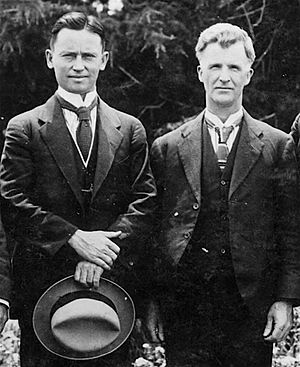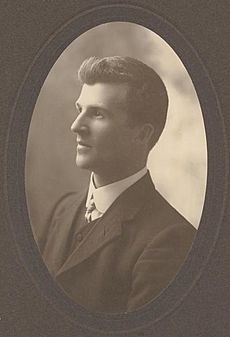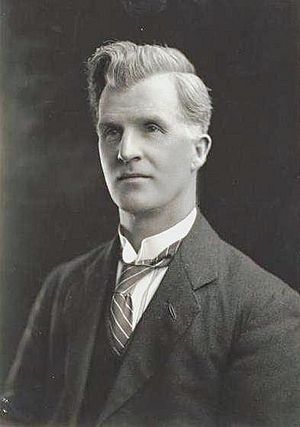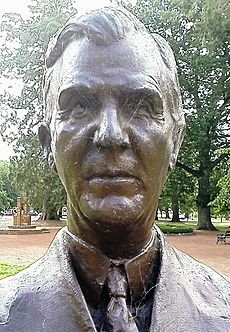James Scullin facts for kids
Quick facts for kids
James Scullin
|
|||||||||||||||||||||||||||||
|---|---|---|---|---|---|---|---|---|---|---|---|---|---|---|---|---|---|---|---|---|---|---|---|---|---|---|---|---|---|

Scullin c. 1930s
|
|||||||||||||||||||||||||||||
| 9th Prime Minister of Australia | |||||||||||||||||||||||||||||
| In office 22 October 1929 – 6 January 1932 |
|||||||||||||||||||||||||||||
| Monarch | George V | ||||||||||||||||||||||||||||
| Governor General |
|
||||||||||||||||||||||||||||
| Deputy | Ted Theodore | ||||||||||||||||||||||||||||
| Preceded by | Stanley Bruce | ||||||||||||||||||||||||||||
| Succeeded by | Joseph Lyons | ||||||||||||||||||||||||||||
| 8th Leader of the Opposition | |||||||||||||||||||||||||||||
| In office 6 January 1932 – 1 October 1935 |
|||||||||||||||||||||||||||||
| Prime Minister | Joseph Lyons | ||||||||||||||||||||||||||||
| Deputy | Frank Forde | ||||||||||||||||||||||||||||
| Preceded by | Joseph Lyons | ||||||||||||||||||||||||||||
| Succeeded by | John Curtin | ||||||||||||||||||||||||||||
| In office 29 March 1928 – 22 October 1929 |
|||||||||||||||||||||||||||||
| Prime Minister | Stanley Bruce | ||||||||||||||||||||||||||||
| Deputy | Arthur Blakeley Ted Theodore |
||||||||||||||||||||||||||||
| Preceded by | Matthew Charlton | ||||||||||||||||||||||||||||
| Succeeded by | John Latham | ||||||||||||||||||||||||||||
| Leader of the Labor Party | |||||||||||||||||||||||||||||
| In office 26 April 1928 – 1 October 1935 |
|||||||||||||||||||||||||||||
| Deputy |
|
||||||||||||||||||||||||||||
| Preceded by | Matthew Charlton | ||||||||||||||||||||||||||||
| Succeeded by | John Curtin | ||||||||||||||||||||||||||||
| Deputy Leader of the Labor Party | |||||||||||||||||||||||||||||
| In office 17 March 1927 – 29 March 1928 |
|||||||||||||||||||||||||||||
| Leader | Matthew Charlton | ||||||||||||||||||||||||||||
| Preceded by | Albert Gardiner | ||||||||||||||||||||||||||||
| Succeeded by | Arthur Blakeley | ||||||||||||||||||||||||||||
|
|||||||||||||||||||||||||||||
|
|||||||||||||||||||||||||||||
| Personal details | |||||||||||||||||||||||||||||
| Born |
James Henry Scullin
18 September 1876 Trawalla, Colony of Victoria |
||||||||||||||||||||||||||||
| Died | 28 January 1953 (aged 76) Melbourne, Australia |
||||||||||||||||||||||||||||
| Resting place | Melbourne General Cemetery | ||||||||||||||||||||||||||||
| Political party | Labor | ||||||||||||||||||||||||||||
| Spouse |
Sarah McNamara
(m. 1907) |
||||||||||||||||||||||||||||
| Education | Mount Rowan State School | ||||||||||||||||||||||||||||
| Occupation |
|
||||||||||||||||||||||||||||
James Henry Scullin (18 September 1876 – 28 January 1953) was an Australian politician and trade unionist who served as the ninth prime minister of Australia, from 1929 to 1932, holding office as the leader of the Australian Labor Party (ALP). During his tenure he also briefly served as the 13th treasurer of Australia from 1930 to 1931. Scullin was the first Catholic, as well as the first Irish-Australian, to serve as Prime Minister of Australia. His time in office was primarily categorised by the Wall Street Crash of 1929 which transpired just two days after his swearing in, which would herald the beginning of the Great Depression in Australia. Despite this Scullin remained a leading figure in the Labor movement throughout his lifetime, and was an éminence grise in various capacities for the party until his retirement from federal parliament in 1949.
Early life
Scullin was born in Trawalla, Victoria on 18 September 1876. His parents, John and Ann (née Logan) Scullin, were both Irish Catholics from County Londonderry. His father was a railway labourer, who emigrated to Australia in his 20s. His mother joined her husband in Australia later. James was the fourth of eight children, and grew up in a tight-knit and devoutly Catholic home. James attended the Trawalla State School from 1881 to 1887 and earned an early reputation as an active and quick-witted boy, though never physically robust. These characteristics would remain with him for life.
The family moved to Mount Rowan, Ballarat, in 1887, and the young James attended school at Mount Rowan State School until 12. Thereafter he held various manual odd-jobs in the Ballarat district until about 1900, and for ten years from 1900 he ran a grocer's shop in Ballarat. In his mid-20s he attended night school, was a voracious reader and became somewhat of an autodidact. He joined a number of societies and was active in the Australian Natives' Association and the Catholic Young Men's Society, eventually becoming president of the latter. He was also a skilled debater, participating in local competitions and having an association with the Ballarat South Street debating society for nearly 30 years, which would prove formative to his interest and talent in politics. Scullin was a devout Roman Catholic, a non-drinker and a non-smoker all his life.
Scullin became active in politics during his years in Ballarat, being influenced by the ideas of Tom Mann and the growing labour movement in Victoria, as were many of his later ministerial colleagues such as Frank Anstey, John Curtin and Frank Brennan. He became a foundation member of his local Political Labor Council in 1903 and was active in local politics thereafter. He was a campaigner and political organizer for the Australian Workers' Union, the union movement with which he would remain most closely associated throughout his career. He spoke often around Ballarat on political issues and helped with Labor campaigns at state and federal level. At the 1906 federal election he was selected as the Labor candidate for the Division of Ballaarat against then Prime Minister Alfred Deakin. Although a race in which Labor had virtually no chance of winning, Scullin ran a spirited campaign and impressed those within the movement for his efforts.
On 11 November 1907 he married Sarah Maria McNamara, a dressmaker from Ballarat. The marriage was childless. Due to Scullin's frequent and often serious bouts of illness over his long career, Sarah served the role as her husband's protector and was a crucial source of support and care for her husband, particularly in his final years. She was frequently called to assist or stand in for her husband at social occasions when her husband's illness prevented him from attending personally. She was an active member of the Labor Party herself, and would remain well-informed on politics. Very unusually among Australian political spouses (and even more so during the period of her husband's career), Sarah would often attend parliamentary sessions, and would even be present during the debate and vote that brought her husband's government down.
Political career

Scullin elected to the Australian House of Representatives first in 1910 and then again in 1922 until 1949. Scullin quickly established himself as a leading voice in parliament, rapidly rising to become deputy leader of the party in 1927 and then Leader of the Opposition in 1928.
After Scullin won a landslide election in 1929, events took a dramatic change with the crisis on Wall Street and the rapid onset of the Great Depression around the world, which hit heavily indebted Australia hard. Scullin and his Treasurer Ted Theodore responded by developing several plans during 1930 and 1931 to repay foreign debt, provide relief to farmers and create economic stimulus to curb unemployment based on deficit spending and expansionary monetary policy. Although the Keynesian Revolution would see these ideas adopted by most Western nations by the end of the decade, in 1931 such ideas were considered radical and the plans were bitterly opposed by many who feared hyperinflation and economic ruin. The still opposition-dominated Australian Senate, and the conservative-dominated boards of the Commonwealth Bank and Loan Council, repeatedly blocked the plans.
With the prospect of bankruptcy facing the government, Scullin backed down and instead advanced the Premiers' Plan, a far more conservative measure that met the crisis with severe cutbacks in government spending. Pensioners and other core Labor constituencies were severely affected by the cuts, leading to a widespread revolt and multiple defections in parliament. After several months of infighting the government collapsed, and was resoundingly defeated by the newly formed United Australia Party at the subsequent 1931 election.
Scullin would remain party leader for four more years, losing the 1934 election but the party split would not be healed until after Scullin's return to the backbenches in 1935. Scullin became a respected elder voice within the party and leading authority on taxation and government finance, and would eventually play a significant role in reforming both when Labor returned to government in 1941. Although disappointed with his own term of office, he nonetheless lived long enough to see many of his government's ideas implemented by subsequent governments.
Death and funeral
Scullin died in his sleep on 28 January 1953 in Hawthorn, Melbourne from complications arising from pulmonary edema. He was accorded a state funeral in St Patrick's Cathedral, Melbourne with a Requiem Mass presided over by Archbishop Daniel Mannix. He was buried in the Catholic section of Melbourne General Cemetery. Over his grave the federal Labor executive and the ACTU erected a monument on behalf of the Labor movement of Australia. The inscription reads: "Justice and humanity demand interference whenever the weak are being crushed by the strong." Scullin's wife, Sarah, was interred with him in 1962. Labor stalwarts Arthur Calwell, Esmond Kiernan, Herbert Cremean and Edward Grayndler are all buried adjacent to the Scullin plot.
Legacy
Scullin had defended his record in government throughout his later career, and took pride in having been Prime Minister in times which might have broken a lesser figure. However he lived long enough to see many of his economic ideas vindicated by history, particularly inflationary financing, which was quite radical by the standards of his times but an accepted pillar of Keynesian economics adopted by Australia and most other Western governments in the late 1930s and 1940s. Indeed, John Maynard Keynes himself would state of Scullin's Premier's Plan which caused him so much woe and electoral unpopularity that it "saved the economic structure of Australia". The Economist admitted after the 1931 election that Scullin "had already done much to place Australia on the high road to recovery".
Several measures which had been proposed and defeated by the UAP opposition (particularly on gold shipments for loan repayments) were subsequently reintroduced and passed by the UAP once in government, giving Scullin some satisfaction. Furthermore, Scullin consoled himself with the fact that the Depression destroyed most of the political careers of those who occupied government through it – only one Australian premier won re-election from 1927 to 1935, and Scullin's foreign contemporaries Herbert Hoover (in the United States of America), Ramsay MacDonald (United Kingdom), Richard Bennett (Canada) and George Forbes (New Zealand) all suffered similarly devastating elections in the wake of the depression. In 1951, 114 manufacturers in Melbourne donated to a fund for Scullin's retirement. Having not forgotten his advocacy of tariffs during their height of unpopularity in the depression, several companies went as far to state that Scullin's efforts had "commenced a new era in the secondary industry field in Australia" and that the success of Australia's wartime industry was due to Scullin's protection of industry during its most vulnerable period a decade earlier.
Scullin's years following his term of government also proved fruitful – he exerted a surprising amount of influence over government policy as Opposition Leader. Scullin was for decades the foremost expert in the Australian parliament on taxation and a variety of other fiscal matters, a fact which rendered his advice very influential within the Curtin government and many of his ideas, having been denied during his own term of government, would eventually be enshrined in the wave of sweeping reforms made by the Curtin/Chifley governments. Scullin was a well-respected figure in politics. Although the target of much bile and disagreement over his policies, he was personally extremely well regarded and had a reputation as a fearless and stoic leader of great personal integrity and fortitude. His resignation as leader in 1935 caused even longtime critic Jack Beasley to admit that Scullin was "a fearless fighter in the exposition of what he believes to be the right course".
Scullin, Australian Capital Territory, a suburb of Canberra, is named after him, as is the Division of Scullin, a House of Representatives electorate. The Scullin monolith in Antarctica was also named in his honour.
Images for kids
-
New Prime Minister James Scullin and former Prime Minister Stanley Bruce hold a private meeting after Scullin's swearing-in as Prime Minister, 1929
-
Scullin with Treasurer Ted Theodore in December 1929
-
Parliament House portrait of Scullin by William Beckwith McInnes, 1938
-
Scullin on the day he handed the reins of power to Joseph Lyons, January 1932.
See also
 In Spanish: James Scullin para niños
In Spanish: James Scullin para niños
- Scullin Ministry


















